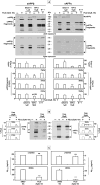Prostaglandin J2 promotes O-GlcNAcylation raising APP processing by α- and β-secretases: relevance to Alzheimer's disease
- PMID: 29149631
- PMCID: PMC5743611
- DOI: 10.1016/j.neurobiolaging.2017.10.009
Prostaglandin J2 promotes O-GlcNAcylation raising APP processing by α- and β-secretases: relevance to Alzheimer's disease
Abstract
Regulation of the amyloid precursor protein (APP) processing by α- and β-secretases is of special interest to Alzheimer's disease (AD), as these proteases prevent or mediate amyloid beta formation, respectively. Neuroinflammation is also implicated in AD. Our data demonstrate that the endogenous mediator of inflammation prostaglandin J2 (PGJ2) promotes full-length APP (FL-APP) processing by α- and β-secretases. The decrease in FL-APP was independent of proteasomal, lysosomal, calpain, caspase, and γ-secretase activities. Moreover, PGJ2-treatment promoted cleavage of secreted APP, specifically sAPPα and sAPPβ, generated by α and β-secretase, respectively. Notably, PGJ2-treatment induced caspase-dependent cleavage of sAPPβ. Mechanistically, PGJ2-treatment selectively diminished mature (O- and N-glycosylated) but not immature (N-glycosylated only) FL-APP. PGJ2-treatment also increased the overall levels of protein O-GlcNAcylation, which occurs within the nucleocytoplasmic compartment. It is known that APP undergoes O-GlcNAcylation and that the latter protects proteins from proteasomal degradation. Our results suggest that by increasing protein O-GlcNAcylation levels, PGJ2 renders mature APP less prone to proteasomal degradation, thus shunting APP toward processing by α- and β-secretases.
Keywords: APP; Apoptosis; O-GlcNAcylation; Prostaglandin J2; Secretases.
Copyright © 2017 Elsevier Inc. All rights reserved.
Conflict of interest statement
Figures







 ). PGJ2-treatment did not alter the intracellular levels of Aβ, while it decreased the levels of secreted Aβ. The scheme depicts the complexity of APP metabolism, rendering it difficult to analyze stoichiometrically. For simplicity, the CTF fragments are not shown under PGJ2-treatment. O-GlcNAc, O-linked β-N-acetylglucosamine.
). PGJ2-treatment did not alter the intracellular levels of Aβ, while it decreased the levels of secreted Aβ. The scheme depicts the complexity of APP metabolism, rendering it difficult to analyze stoichiometrically. For simplicity, the CTF fragments are not shown under PGJ2-treatment. O-GlcNAc, O-linked β-N-acetylglucosamine.Similar articles
-
Amyloid precursor protein glycosylation is altered in the brain of patients with Alzheimer's disease.Alzheimers Res Ther. 2020 Aug 12;12(1):96. doi: 10.1186/s13195-020-00664-9. Alzheimers Res Ther. 2020. PMID: 32787955 Free PMC article.
-
Mechanisms that synergistically regulate η-secretase processing of APP and Aη-α protein levels: relevance to pathogenesis and treatment of Alzheimer's disease.Discov Med. 2017 Feb;23(125):121-128. Discov Med. 2017. PMID: 28371615 Free PMC article.
-
Decrease in brain soluble amyloid precursor protein β (sAPPβ) in Alzheimer's disease cortex.J Neurosci Res. 2011 Jun;89(6):822-32. doi: 10.1002/jnr.22618. Epub 2011 Mar 23. J Neurosci Res. 2011. PMID: 21433051
-
Trafficking and proteolytic processing of amyloid precursor protein and secretases in Alzheimer's disease development: An up-to-date review.Eur J Pharmacol. 2019 Aug 5;856:172415. doi: 10.1016/j.ejphar.2019.172415. Epub 2019 May 24. Eur J Pharmacol. 2019. PMID: 31132354 Review.
-
A Greek Tragedy: The Growing Complexity of Alzheimer Amyloid Precursor Protein Proteolysis.J Biol Chem. 2016 Sep 9;291(37):19235-44. doi: 10.1074/jbc.R116.746032. Epub 2016 Jul 29. J Biol Chem. 2016. PMID: 27474742 Free PMC article. Review.
Cited by
-
Involvement of Lipids in Alzheimer's Disease Pathology and Potential Therapies.Front Physiol. 2020 Jun 9;11:598. doi: 10.3389/fphys.2020.00598. eCollection 2020. Front Physiol. 2020. PMID: 32581851 Free PMC article. Review.
-
Physical Exercise and Alzheimer's Disease: Effects on Pathophysiological Molecular Pathways of the Disease.Int J Mol Sci. 2021 Mar 12;22(6):2897. doi: 10.3390/ijms22062897. Int J Mol Sci. 2021. PMID: 33809300 Free PMC article. Review.
-
Exhaled breath condensate profiles of U.S. Navy divers following prolonged hyperbaric oxygen (HBO) and nitrogen-oxygen (Nitrox) chamber exposures.J Breath Res. 2023 Jun 12;17(3):10.1088/1752-7163/acd715. doi: 10.1088/1752-7163/acd715. J Breath Res. 2023. PMID: 37207635 Free PMC article. Clinical Trial.
-
Aggregation Behavior of Amyloid Beta Peptide Depends Upon the Membrane Lipid Composition.J Membr Biol. 2024 Aug;257(3-4):151-164. doi: 10.1007/s00232-024-00314-3. Epub 2024 Jun 18. J Membr Biol. 2024. PMID: 38888760 Review.
-
Nutritional Mushroom Treatment in Meniere's Disease with Coriolus versicolor: A Rationale for Therapeutic Intervention in Neuroinflammation and Antineurodegeneration.Int J Mol Sci. 2019 Dec 31;21(1):284. doi: 10.3390/ijms21010284. Int J Mol Sci. 2019. PMID: 31906226 Free PMC article. Clinical Trial.
References
-
- Aoki T, Narumiya S. Prostaglandins and chronic inflammation. Trends Pharmacol Sci. 2012;33:304–311. - PubMed
-
- Bateman RJ, Xiong C, Benzinger TL, Fagan AM, Goate A, Fox NC, Marcus DS, Cairns NJ, Xie X, Blazey TM, Holtzman DM, Santacruz A, Buckles V, Oliver A, Moulder K, Aisen PS, Ghetti B, Klunk WE, McDade E, Martins RN, Masters CL, Mayeux R, Ringman JM, Rossor MN, Schofield PR, Sperling RA, Salloway S, Morris JC. Clinical and biomarker changes in dominantly inherited Alzheimer’s disease. N Engl J Med. 2012;367:795–804. - PMC - PubMed
-
- Benzing WC, Mufson EJ, Armstrong DM. Alzheimer’s disease-like dystrophic neurites characteristically associated with senile plaques are not found within other neurodegenerative diseases unless amyloid beta-protein deposition is present. Brain Res. 1993;606:10–18. - PubMed
-
- Berridge MV, Tan AS. Characterization of the cellular reduction of 3-(4,5-dimethylthiazol-2-yl)-2,5-diphenyltetrazolium bromide (MTT): subcellular localization, substrate dependence, and involvement of mitochondrial electron transport in MTT reduction. Arch Biochem Biophys. 1993;303:474–482. - PubMed
Publication types
MeSH terms
Substances
Grants and funding
LinkOut - more resources
Full Text Sources
Other Literature Sources
Medical

